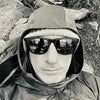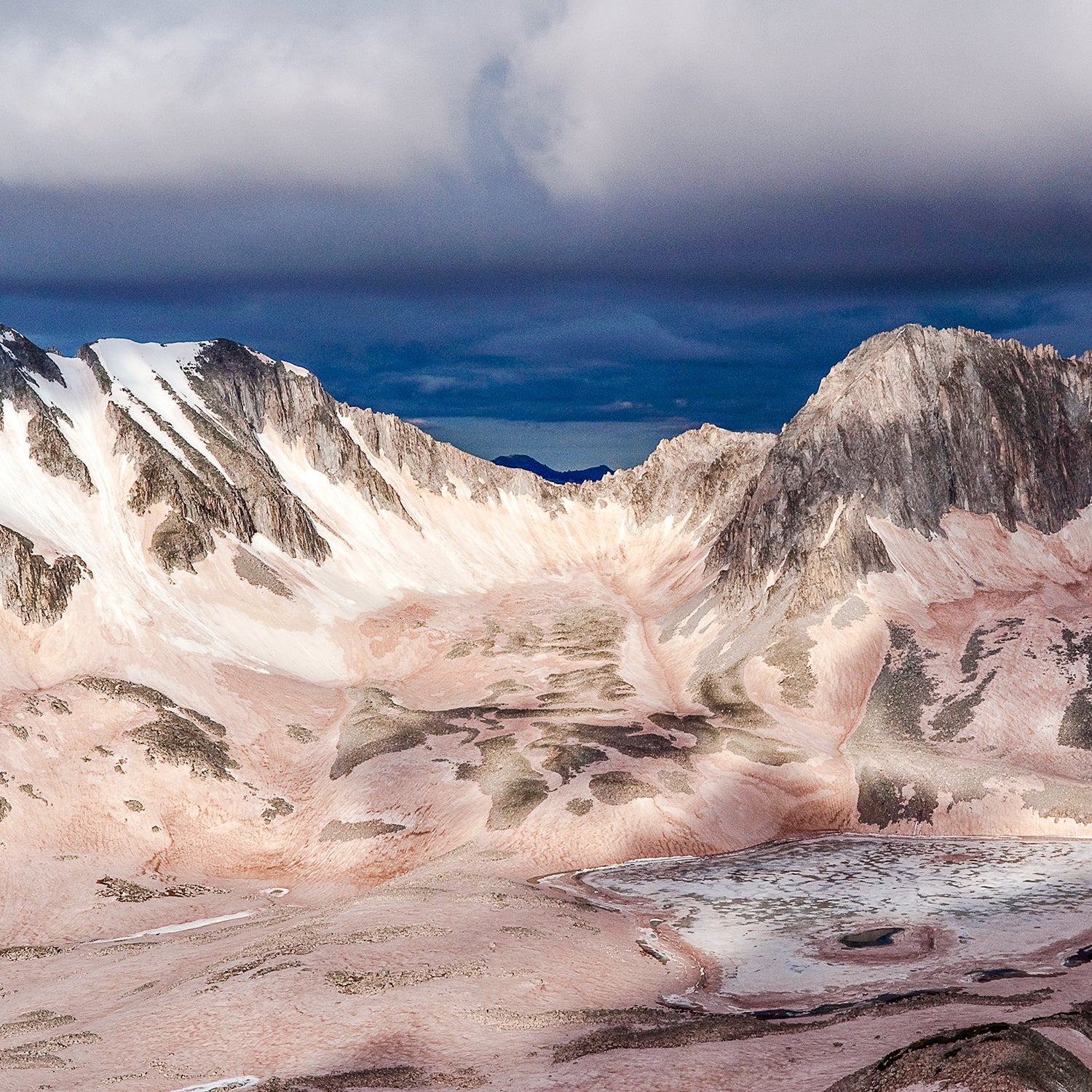If irony is the hygiene of the mind, then it’s also the scourge of Tom Painter’s sinuses. Painter, 52, allergic to both dust and soot, is laid low by migraines when he inhales either one. But here’s the ironic bit: Painter is the world’s authority on light-absorbing particles like dust and soot—schmutz, in Painter’s parlance—and how they are corroding mountain snowpacks everywhere. Schmutzy snow, Painter says, lowers snow’s reflectivity, or albedo (rhymes with libido). While high-albedo snow reflects upwards of 90 percent of earthbound solar energy back into the atmosphere, dusty low-albedo snow causes snowpacks to melt nearly two months early.
Schmutz’s deleterious effect on snow is widespread and is increasing at an alarming rate—so much so that Painter and his NASA colleagues believe that climate change has likely been given too much credit for the diminution of mountain snowpacks and particulate matter too little. To wit: In 2013, Painter published showing how black carbon particulate from the industrial revolution’s smokestacks snuffed out Europe’s Little Ice Age. His most recent work shows that high-dust years lead to a rise in melt independent of temperature.
If you’re a skier or a water drinker, schmutz matters—especially if you live west of the Great Plains. The American West’s water delivery system assumes water melts from mountains come spring and trickles into reservoirs during spring and early summer, where it’s then stored for use throughout the year. Precipitation, much of which comes from snow, is the source of 75 percent of that water. Premature runoff means shallower ski runs, sure, but also less freshwater for table and crops.
Eolian dust, or windblown silt, such as the grains of sand transported from the world’s great deserts, has always found its way into mountain snow. But Painter is seeing a greater prevalence of dust stirred up by humans. The steady creep of desertification—the stripping of plants, nutrients, microbes, and crust from the earth’s surface—stems from overgrazing, over-farming, clear-cutting, land development, recreational off-road vehicle use, and even hiking off-trail. One estimate puts the global rate of desertification at about 30 million acres of arable land a year, or a football field every second, and the United States isn’t immune to its ravages.
Drought equals dust. In 2015, farmers in California’s Central Valley abandoned crops due to diminishing groundwater stores caused by a four-year drought and an anemic snowpack in the Sierra Nevada. Ground that should have been green was brown and vulnerable to wind transport atop the scanty Sierra snow. In the mid- to late-2000s, a series of extreme dust storms began to boil up from the Colorado Plateau and coated the southern Rockies in a patina of rouge. “It’s literally snowing dirt,” says Mike Kaplan, president and CEO of Aspen Skiing Co. “It’s almost like out an apocalyptic movie. You go from glorious majestic white mountains to these dirty-looking mountains, and a whole winter’s worth of snowpack changes overnight.”
Soot is essentially black carbon, and that side of the equation is a bit more straightforward. Soot is produced by the incomplete combustion of fossil fuels from, say, diesel engines, industrial emissions, and burning biomass, like wildfires, which are on the rise because of climate change.
Despite their potential for harm, dust and soot weren’t acknowledged as a scourge of snowpacks until a little more than a decade ago, when Painter and extreme skier turned scientist Chris Landry ventured into southwest Colorado’s Senator Beck Basin to calculate the effects of dust on the timing of winter runoff. Their findings? “Not only does dust bring peak runoff several weeks earlier at the Colorado River’s Lee’s Ferry,” Painter says, “but it also has decreased the annual flow by about 5 percent each year.” Painter figures that 5 percent is enough to satisfy the water requirements of Las Vegas for 18 months.
The scientist in Painter knows better than to opine on data he hasn’t yet collected, but key clues point to grim news, even on the globe’s highest snowfields.
Painter and Landry looked at two key metrics: snow albedo’s effect on the timing of the snowpack’s runoff, and the volume of pure water lurking in entire sub-basins. Snow scientists call that latter measurement the snow water equivalent (SWE). To the Department of Agriculture, SWE means “the depth of water that would theoretically result if you melted the entire snowpack instantaneously.” Join SWE and snow albedo in one algorithm, and you get a dream come true for municipal water managers, who can now determine how much and when the snowmelt will hit their reservoirs. “Water managers don’t have to commit to billion-dollar decisions with really, really fuzzy information,” says Painter. “They now know how much SWE there is in every sub-basin.”
If the Senator Beck Basin calculations laid the groundwork for everything Painter does now at NASA, his method of data acquisition (by hand, in the field) and mode of travel (by ski) did not. He collects his metrics at 20,000 feet from the belly of a Beechcraft King Air twin-turboprop. Onboard lidar measures SWE, and a spectrometer measures snow albedo. Officially, it’s called the (ASO). Unofficially, it’s Painter’s brainchild, and it has disrupted the business of measuring the volume and timing of mountain meltwater. Every western water manager wants a piece of it: Oregon, Colorado, and Wyoming. “It’s crazy,” Painter told a group of water scientists two years ago at the University of Nevada, Reno. “The phone is ringing all the time.”
I don’t ring Painter’s phone; I text it. We meet in the austere concrete-and-glass surround of Mammoth’s Black Velvet coffeehouse to talk snow and water and feedback loops. “We’re finally starting, as a community, to understand this,” he says, referring to the way schmutz and temperature are wrecking the global snowpack. “There were a few of us that really had this first glimpse into it. But the broader community is starting to understand that, yeah, this is actually really, really powerful in a lot of places that we hadn’t realized it was powerful.”
That realization is evolving, says Painter, simply because no one’s had the technology to efficiently measure snow albedo on a global scale. Scientists still can’t tell us, for example, precisely how much water we’re losing to light-absorbing particles in the American West. “There’s much to understand in the West and across the rest of the globe,” Painter says.
But that could change in about ten years, when Painter hopes to hitch radar and a spectrometer to a satellite. The scientist in him knows better than to opine on data he hasn’t yet collected, but key clues point to grim news, even on the globe’s highest snowfields. “The few ice cores extracted from the Himalaya, for example, show dust deposition dating back to the 1850s and climbing steadily ever since,” Painter says. Data rolling in from the Andes, the Alps, the Caucasus, Antarctica, the Cascades, and the Sierra show increased loads of both black carbon and dust dating back to the Industrial Revolution. “So I think we’ve kind of gotten past the surprise stage,” he says.
“The ski experience is beside the point,” Kaplan says. “This is about these mountain watersheds. They’ve got to maintain their integrity, or we’ve got much bigger problems to solve.”


